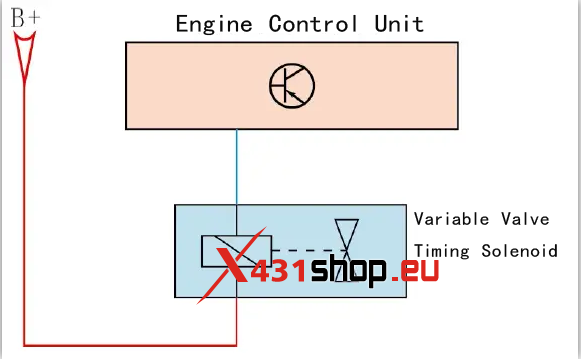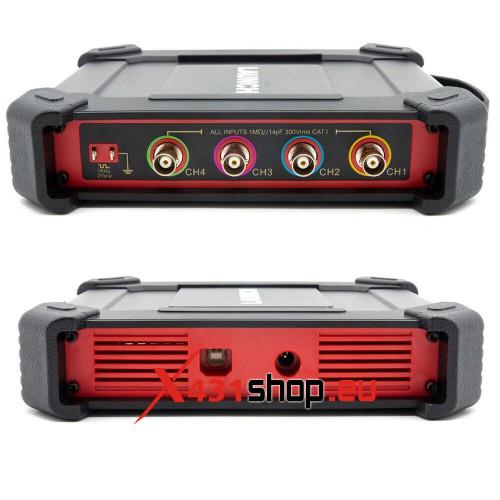
Most automotive maintenance personnel have not used oscilloscopes and are accustomed to using multimeters to detect car faults. They are unfamiliar with the functions of oscilloscopes and consider them mysterious. In the following, the author introduces some main performance parameters of oscilloscopes to unveil its mysteries.
Why use an oscilloscope for car repairs? The refresh rate of a digital multimeter is usually around 2 times per second (some high-end ones can reach 4 times per second). When measuring a signal voltage with it, the displayed reading on the screen is not the actual voltage but an average voltage due to the slower refresh rate.
For example, when measuring the voltage of a “Variable Valve Timing Solenoid Circuit” with a multimeter, the voltage is around 8.7V. Is this the actual voltage?

Explanation: The red line is the power supply line, and the engine control unit controls the blue line (control line).
Using an oscilloscope reveals that the voltage on the control line fluctuates between low (about 0.28V) and high (about 14.6V), indicating a pulse-width modulation signal with a duty cycle of approximately 40%. The voltage measured using a multimeter is 8.7V, which cannot be said to be wrong, but it is inaccurate.

The oscilloscope’s rapid refresh rate, exceeding a million times per second, allows it to capture multiple voltage values in a very short time and plot them as curves. This visual representation helps maintenance personnel intuitively see how the signal changes, giving oscilloscopes an unparalleled advantage compared to other measuring devices.
Now that we understand why oscilloscopes are used for car repairs, let’s explore the types of oscilloscopes.
In simple terms, oscilloscopes can be divided into analog oscilloscopes and digital oscilloscopes. Analog oscilloscopes, resembling old-fashioned cathode-ray tube televisions, provide high resolution and real-time waveform display but lack storage capabilities. Like the picture below, this It is a very typical analog oscilloscope.

Digital oscilloscopes, especially digital storage oscilloscopes (DSO), are commonly used in automotive maintenance due to their ability to store waveforms for an extended period and perform various complex operations.
For automotive diagnostics, DSO with specific performance indicators are preferred. These indicators include:
Channels: The number of simultaneously measurable signals. When checking the engine, at least 2 channels are needed. For ordinary engines, 2 channels are used; but for 4-cylinder engines, 3 channels are needed. If a dual-channel oscilloscope is used, it can only be divided into 2 times measurement. Automotive maintenance typically uses 2-channel or 4-channel oscilloscopes.
Bandwidth: The highest frequency a signal can pass through the oscilloscope’s front-end amplifier. The bandwidth should be at least five times the maximum frequency of the measured signal. For example, the transmission rate of a high-speed CAN bus is 500kbit/s, and the theoretical bandwidth is 2.5 A MHz oscilloscope is sufficient. The bandwidth of most automotive-specific oscilloscopes is above 20MHz, which is far beyond the demand (the bandwidth of LAUNCH-X431 Sensorbox Oscilloscope is 100MHz).
Storage Depth: The number of sample points the oscilloscope can save. A higher storage depth allows for more accurate waveform representation. When multiple channels are turned on, the storage depth will also be evenly distributed by each channel. For example, the storage depth of the oscilloscope is 2Mpts. When using 2 channels, the storage depth is reduced to 1Mpts per channel.
After understanding the performance indicators, the choice of oscilloscope form factor depends on preferences:
Benchtop oscilloscopes are affordable but bulky and require power. They are generally not suitable for automotive maintenance.
Handheld oscilloscopes are portable with built-in batteries, making them suitable for automotive repairs despite their smaller screens.
Tablet oscilloscopes resemble tablet computers, offering a large touchscreen and portability.
Virtual oscilloscopes transfer data to a computer for display, providing a high-resolution screen but requiring a laptop.
For those looking for a recommended oscilloscope, the LAUNCH-X431 Sensorbox Oscilloscope is suggested. It has a bandwidth of 100MHz, a storage depth of 10M (for 4 channels), and is compatible with LAUNCH-X431 diagnostic tablet devices. It eliminates the need for a laptop, making it an excellent choice for users who already own LAUNCH diagnostic equipment.











